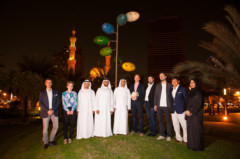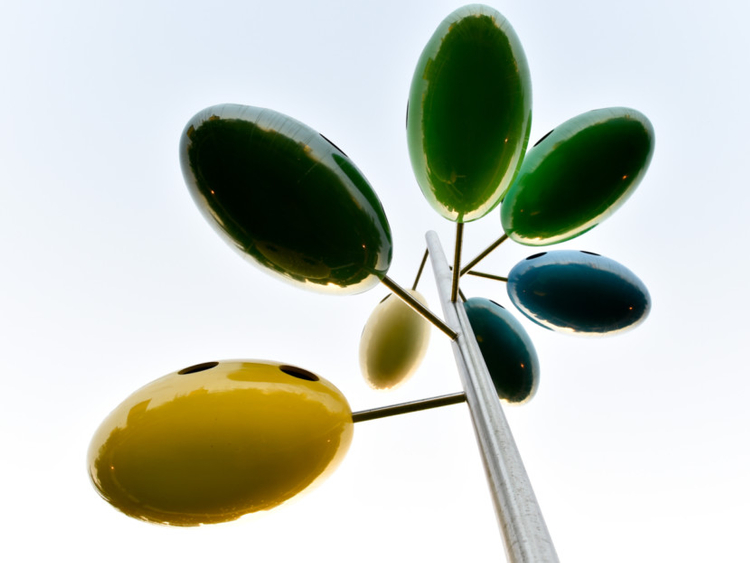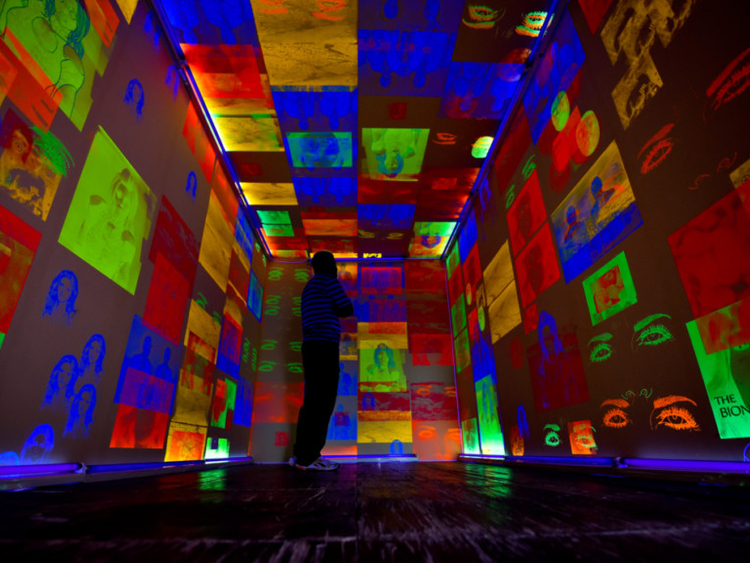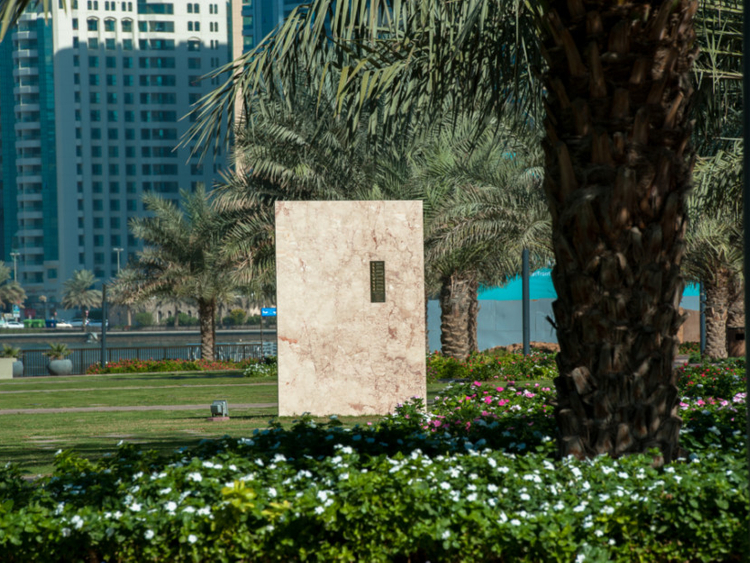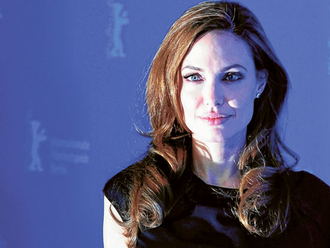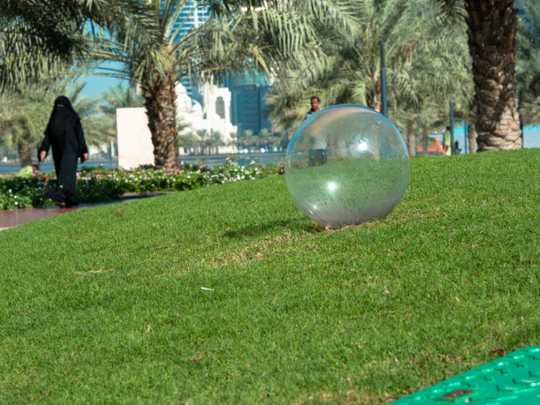
If you are planning to visit the Al Majaz Waterfront in Sharjah for a stroll, and come across something out of the ordinary in a park, no need to look around for answers. Boldly go ahead and explore the installation before you.
These seven exhibits are part of an outdoor sculpture show titled “Imitation Game” for Maraya Art Park, curated by Dr Alexandra MacGilp.
Pie of Trouble. Let’s Hang. Breathe. Air for Free by Sonja Gerdes; steel, ceramic and wool, 2015
And the seven invited artists — Fayçal Baghriche, Nick Ferguson, Tatiana Echeverri Fernandez, Sonja Gerdes, Ludovica Gioscia, Hans Rosenström and Kim Schoen — explore what makes us human in the digital age.
“The title of the show ‘Imitation Game’ refers to the Turing Test. In 1950, the mathematician Alan Turing, who invented the computer, posed the question, ‘can machines think?’ The Turing Test he proposed was designed to examine a machine’s ability to exhibit intelligent behaviour, indistinguishable from that of a human,” Dr MacGilp tells Weekend Review.
Dr MacGilp then proceeds to give us a quick round-up of the works displayed, saying all the works “make a carefully considered visual impact in the park, a valued green space in Sharjah where a wide range of people exercise and socialise”.
“Baghriche highlights how precious the commodity water is and Gerdes, the need to find long-term alternative energy sources to oil. Ferguson applies Utopian modernist architecture design to create a house for birds and is interested to see what breeds — local or migratory — will settle there. In her container wallpaper installation, Gioscia looks at female cyborgs from the nostalgic figure of the Bionic Woman from the 1970s, to today’s chatbots such as Evie who she conversed with to produce the work, and LaTurbo Avedon, an avatar-artist from Second Life. Rosenström examines how we interact with each other in real life with the power of the human voice. Fernandez has used the age-old technology of pottery vases as a metaphor for the human body, creating three towers with a playful water feature.”
Memory is one thing that machines are not able to imitate and this is addressed poetically. Our interaction with the chatbots who increasingly haunt the online world is examined. Exuberant sculptures and installations playfully examine the torrent of consumerism that engulfs our everyday existence and how it moulds our identity.
The artists address the histories of the built environment, urban and rural, that surrounds and shapes us. They imagine alternative presents and futures as well as make us aware of our physical body and the space around it. They probe our uneasy relationship with the natural world, our desire for fantasy and escape, our yearning nostalgia for a lost Utopian future.
Sharjah has undergone rapid development over the last 50 years. Yet the arid landscape and intense summer heat have imposed multiple constraints on habitation, necessitating advancements in architecture and engineering that have rendered this desert city a test site for creative dwelling. If, increasingly, climate change and global population expansion are the defining elements of our time, it is possible that Sharjah, at a technological level at least, may be a precursor of the directions cities might evolve elsewhere.
Ferguson has designed a custom-made birdhouse called “Futuro Estate” out of fibreglass pods, inspired by futuristic architecture design from the 1960s. The project provides an opportunity to see what it looks like afresh and consider what could have happened for long-abandoned architecture of the future to be scaled for use by the birds that share the city, and to be re-presented as art. Unlike the dovecotes that grace rural residencies elsewhere in the Middle East, and which provide a home for birds that serve as both companion and food, “Futuro Estate” is proposed as a resource for feral birds.
Ding Dong by Kim Schoen; marble, brass, concrete, wiring, speakers, 2015
Visitors are able to discover which species, if any, would make use of it and whether it serves simply as a platform on which to gather, see and be seen, or be colonised for nesting.
Baghriche is also interested in the conditions of urban dwelling in Sharjah, viewing the city as a surface transplanted over a desert environment. He makes an intervention into the watering system of the park, “Allégresse, insolence”, causing a partial interruption so the grass would dry through and become yellow and thin, revealing very quickly the true character of the land surface, which is sandy.
Fernandez also plays with water in her sculpture “Fräulein Alba, Fräulein Aisha and Fräulein Arij”. These three towers were made out of pots sourced from a local pottery, Al Fakhr. The artist is interested in how these objects are formally unchanged since prehistoric times but can carry new metaphors in changing times and relate strongly to bodily forms. The towers surprise visitors to the park with a hidden water feature.
Gerdes is fascinated with how we will live in the future and fantasy alternatives to our current reality. She brought her “Oxygenenergizer” project to Sharjah in the form of an advertising campaign, ceramic and steel sculpture and performance in the park. With it, she challenges us to imagine that oxygen could fuel engines as it does humans.
Close by, Gioscia invites us into the luminous interior of her container in the park. Inside it, her screen-printed wallpapers glow under UV lights. These hand-made sheets celebrate female characters that are part artificial intelligence or are born on virtual platforms. One is the Bionic Woman from the 1970s TV series the artist watched as a child. This was her first encounter with a cyborg, and shaped her consequent understanding of AI as something that could exist within us. Other characters who appeared in the installation were the contemporary chatbot Evie and Second Life avatar La Turbo Avedon. In fact, online conversations with Evie helped the artist determine the direction of the project.
“Ding Dong” by Kim Schoen is an interactive sculpture — a sound installation comprising a curtain wall façade made of marble with a doorbell — that explored the tension between programmed and spontaneous speech, sense and nonsense, memory and forgetting. It consists of four short plays — conversations between “spoofed” names from spam e-mails, and an AI chatbot in Arabic. These conversations are theatrical and nonsensical in nature. They became arguments because the chatbot algorithm uses antagonism as a strategy to allow a conversation topic to switch abruptly, with no reference to what was said before. “This resistance to memory is paradoxically the most non-human component of a programme designed to be human,” says Schoen.
Meanwhile, Rosenström created a poetic sound sculpture for the park, recorded in English and Arabic by local performers. With it he explored what makes us human and how we relate to each other in “real life”. The power of the human voice is something personal and private that still has the power to transcend boundaries and bring us together.
Imitation Game runs at Maraya Art Park, Al Majaz Waterfront, Sharjah, until May 14.
Dr Alexandra MacGilp: Committed to pioneering art in public space
The Curator of “Imitation Game” speaks to Weekend Review in an exclusive interview.
What were the main motivating factors behind choosing this subject to curate?
It is a subject I have been thinking about for a while. The idea came out of a conversation with the artist Kim Schoen, who is part of the exhibition, regarding her ongoing project “Ding Dong”, in which she creates absurd dialogues with spambot algorithms that explore what it means to be human. In essence it is memory that defines us. Computers cannot imitate memory, but they can distract by using antagonistic strategies.
This topic is particularly relevant in the Gulf region where the harsh climate makes mankind more reliant on technology to exist. As the writer Sophia Al Maria has discussed, life in the Gulf is a prediction of the future of the planet. The residents of this country are also enthusiastic early adopters of many technologies as well as of social media. I am very interested in thinking about what it means to be human and how we strive to improve our environment. Have we entered the future we dreamt about?
What are the elements that went into the planning for this show and how long did it take?
I have been thinking about this exhibition for a year and I adapted the original concept to suit the location of the park. The focus expanded to include our relationship with the natural environment and future scenarios. The artists enjoyed making works that involved interaction with the users of the park, both humans and birds.
Several of the works were produced in stages, for example, Hans Rosenström and Schoen wrote texts which were then translated into Arabic and recorded with performers. Ludovica Gioscia designed and made her screen-printed wallpapers in her studio in the UK and they were sent here to be installed. Sonja Gerdes created her sculpture in Berlin and then re-assembled and painstakingly painted it here. Tatiana Echeverri Fernandez selected her vases from a local pottery, Nick Ferguson worked with a local fibreglass manufacturer. Schoen and Fayçal Baghriche designed their works to use materials available locally.
The artists were all inspired by conditions of this region.
How did you zero in on the seven artists for this show?
The artists are an international group of seven nationalities living in Los Angeles, Berlin, London and Paris. They were either working with this theme already or made new works in response to it. I have for long known and admired the work of several of the artists involved; in the case of Ferguson, Gioscia and Fernandez, for more than a decade. I have exhibited their works previously in London where I used to live and I am very happy to have a chance to introduce them to Sharjah. It is the first time they have exhibited in this region.
I met Baghriche when we were residents together at AiR Dubai in 2012. I have followed his practice with interest ever since. He has a close relationship with this country, he has shown at Art Dubai and Maraya Art Centre and his work is in the Barjeel collection.
Finnish artist Rosenström was part of “Encounter: Listening to the City” which I curated in Maraya Art Park in 2014. I received so much positive feedback about his work that I wanted to invite him again to make a new site-specific work with local performers.
I met other artists such as Gerdes more recently during studio visits in Berlin.
Did you consider any artists practising in the UAE for “Imitation Game”?
Yes, I had two artists I wanted to work with for this exhibition from the Gulf but unfortunately scheduling conflicts prevented it on this occasion.
Please list the outdoor shows you have curated for Maraya Art Centre.
So far in the Maraya Art Park we have had “The Hierarchy of Being” by Wafaa Bilal, ISEA 2014 and “Encounter: Listening to the City” as well as a project by Vikram Divecha as part of “Accented”. And of course we have the magnificent mural by calligrafitti artist eL Seed in Bank Street, part of our Jedariya programme. We have more outdoor commissions coming up in 2016, which we will announce in due course. Keep an eye on our social media.
How was the feedback to these outdoor exhibitions and in particular for “Imitation Game”?
The feedback has been positive. It’s been rewarding to see both those who work and those who spend their leisure time in the park interact with the works. I feel we are laying a foundation for increasingly ambitious projects in the future.
Outdoor public art is quite new here but I think people are curious. There are challenges, of course; it is not a white cube gallery space.
I hope that young people particularly will enjoy the works. For example, watching birds settle in Ferguson’s birdhouse “Futuro Estate”.
The park really comes to life in the evening and I hope that visitors will take the chance to reflect on what it means to be human as they promenade in the park.
Al Majaz is already a well-loved venue for exercise, socialising, dining and special events. With “Encounter: Listening to the City”, people enjoyed the interactive works and the live performances I programmed were well-attended. This demonstrated that there was an audience waiting to be activated. I am committed to pioneering art in public space.
N.P. Krishna Kumar is a freelance writer based in Dubai.


